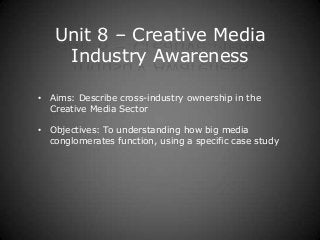
Cross Industry Ownership (DAPS 6)
- 1. Unit 8 – Creative Media Industry Awareness • Aims: Describe cross-industry ownership in the Creative Media Sector • Objectives: To understanding how big media conglomerates function, using a specific case study
- 2. Cross-Industry Ownership • When one company or person has stakes in several areas of the media industry • Examples? • Richard Desmond owns OK! Magazine, Channel 5, the Daily Express and the Daily Star • Rupert Murdoch: The Sun, The Sunday Times, The Times, 39% of BskyB, 20th Century Fox, Intermix Media Inc.
- 3. News Corps bid for BSkyB • When did it all begin? • Rupert Murdoch’s News Corporation is seeking to take full control of satellite broadcaster BSkyB, by acquiring the 60.9% of the shares it does not already own • Why did the sale matter so much? • News Corporation is the UK’s largest newspaper publisher, printing more than one in three copies sold. Sky is the largest broadcaster, with turnover of £5.9bn against the BBC’s £4.8bn. The Murdoch family say a merger makes good financial sense, but critics say it would create a media group of unprecedented power, in which newspapers could be bundled with a Sky subscription, or Sky sports content could be shown exclusively on Times and Sun websites
- 4. News Corps bid for BSkyB • Doesn’t Murdoch already control Sky? • No, he owns 40% of the voting shares in News Corp. It in turn owns 39.1% of BSkyB, with others holding the rest. Although Rupert’s son James is BSkyB’s chairman, the two companies are separate entities. • What is the vital criterion? • Cross-media power. Cross-media ownership rarely triggers competition law concerns, because TV and papers are considered distinct markets. Ofcom, though, is judging the deal by “public interest” considerations: whether the number of independent voices in media will be reduced as a result of a super-Murdoch company. This is known as the media plurality test.
- 5. News Corps bid for BSkyB • BBC documentary on Murdoch and his ever increasing power and bid for world domination…